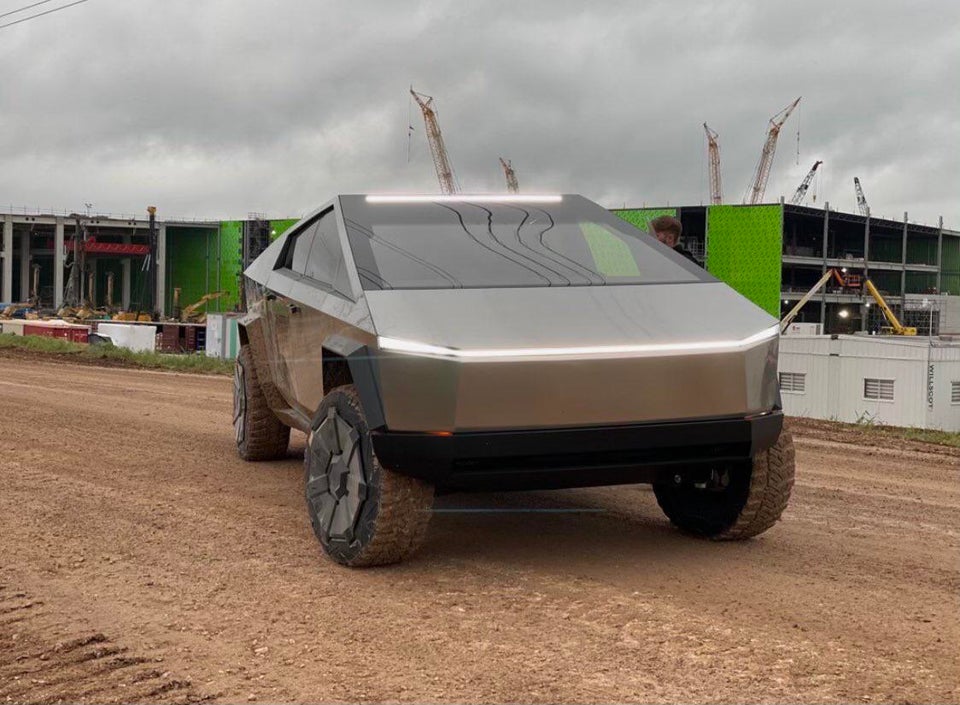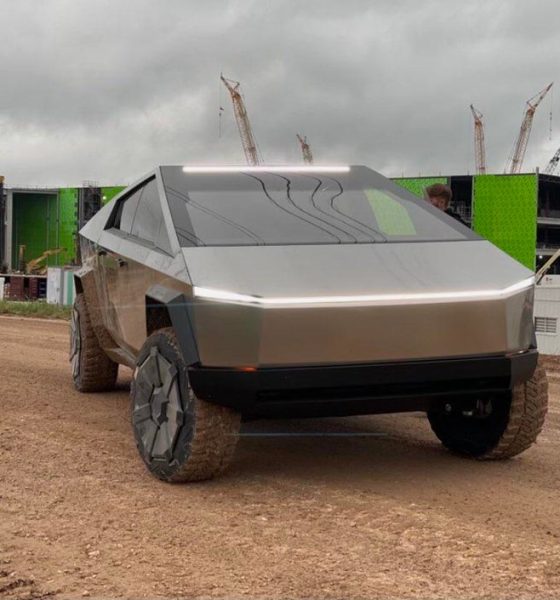

News
Tesla’s Elon Musk gives production update for Giga Texas, but it’s not for the Cybertruck
Tesla CEO Elon Musk visited the Gigafactory Texas site earlier this week with the all-electric Cybertruck that will be produced at the automaker’s factory in the Lone Star State. After various users shared some photographs of the Cybertruck roaming around the still dirt-covered grounds of the Texas factory, Musk gave an update on production timelines for the plant. Interestingly, the plans didn’t include an estimation for the Cybertruck, only for the Model Y crossover.
Musk says that the Model Y will enter a limited production phase this year, with a high volume approach coming in 2022. While quickly becoming the second most popular vehicle in Tesla’s lineup, the Model Y is not the star of the show in Texas; the Cybertruck is. While production for that vehicle was set to begin in late 2021, the automaker said at the unveiling event it held for the truck in November 2019, there is no update from Musk on whether the Cybertruck will ultimately begin deliveries to customers by the end of the year.
Limited production of Model Y this year, high volume next year
— Elon Musk (@elonmusk) April 16, 2021
It seems Tesla’s preparations for the Cybertruck are becoming delayed due to unforeseen circumstances. Interestingly, it doesn’t appear to have anything to do with the production of the Giga Texas factory itself, as crews have been able to build the plant from the ground up in an impressive fashion. One local Texas government official recently told Teslarati that the speed of the construction process in Austin is incredibly quick, and it’s nearly unbelievable how fast things are coming together.
While several followers of Musk on Twitter inquired about Cybertruck production updates, Musk chose to only reveal the most recent details in Model Y production instead. The most recent update on the Cybertruck’s design and production was given by the Tesla CEO on a recent episode of the Joe Rogan Experience Podcast.
We do know that Tesla had been considering a slight design modification of the Cybertruck to make it slightly more drivable in maneuverable in streets and residential garages. Ultimately, Tesla did not want to sacrifice the Cybertruck’s design, and only adjusted the truck’s size by “around 3% or smaller,” Musk said in the Rogan interview. “You don’t want it to be a couple of inches too big for the tunnel,” he said in reference to the Boring Company’s projects. Musk has said that photographs of the new Cybertruck will likely be released in Q2, but they have not been shared yet.
Musk also that the automaker might be able to manufacture a few units before 2021 ends. “If we get lucky, we’ll be able to do a few deliveries toward the end of this year, but I expect volume production to be in 2022.”
Musk stated that these updates were also accurate for production at Giga Berlin, Tesla’s first European production facility, a project that is frustrating Tesla due to delays.
Same with Berlin
— Elon Musk (@elonmusk) April 16, 2021

Elon Musk
Elon Musk’s X will start using a Tesla-like software update strategy
The initiative seems designed to accelerate updates to the social media platform, while maintaining maximum transparency.

Elon Musk’s social media platform X will adopt a Tesla-esque approach to software updates for its algorithm.
The initiative seems designed to accelerate updates to the social media platform, while maintaining maximum transparency.
X’s updates to its updates
As per Musk in a post on X, the social media company will be making a new algorithm to determine what organic and advertising posts are recommended to users. These updates would then be repeated every four weeks.
“We will make the new 𝕏 algorithm, including all code used to determine what organic and advertising posts are recommended to users, open source in 7 days. This will be repeated every 4 weeks, with comprehensive developer notes, to help you understand what changed,” Musk wrote in his post.
The initiative somewhat mirrors Tesla’s over-the-air update model, where vehicle software is regularly refined and pushed to users with detailed release notes. This should allow users to better understand the details of X’s every update and foster a healthy feedback loop for the social media platform.
xAI and X
X, formerly Twitter, has been acquired by Elon Musk’s artificial intelligence startup, xAI last year. Since then, xAI has seen a rapid rise in valuation. Following the company’s the company’s upsized $20 billion Series E funding round, estimates now suggest that xAI is worth tens about $230 to $235 billion. That’s several times larger than Tesla when Elon Musk received his controversial 2018 CEO Performance Award.
As per xAI, the Series E funding round attracted a diverse group of investors, including Valor Equity Partners, Stepstone Group, Fidelity Management & Research Company, Qatar Investment Authority, MGX, and Baron Capital Group, among others. Strategic partners NVIDIA and Cisco Investments also continued support for building the world’s largest GPU clusters.
News
Tesla FSD Supervised wins MotorTrend’s Best Driver Assistance Award
The decision marks a notable reversal for the publication from prior years, with judges citing major real-world improvements that pushed Tesla’s latest FSD software ahead of every competing ADAS system.

Tesla’s Full Self-Driving (Supervised) system has been named the best driver-assistance technology on the market, earning top honors at the 2026 MotorTrend Best Tech Awards.
The decision marks a notable reversal for the publication from prior years, with judges citing major real-world improvements that pushed Tesla’s latest FSD software ahead of every competing ADAS system. And it wasn’t even close.
MotorTrend reverses course
MotorTrend awarded Tesla FSD (Supervised) its 2026 Best Tech Driver Assistance title after extensive testing of the latest v14 software. The publication acknowledged that it had previously criticized earlier versions of FSD for erratic behavior and near-miss incidents, ultimately favoring rivals such as GM’s Super Cruise in earlier evaluations.
According to MotorTrend, the newest iteration of FSD resolved many of those shortcomings. Testers said v14 showed far smoother behavior in complex urban scenarios, including unprotected left turns, traffic circles, emergency vehicles, and dense city streets. While the system still requires constant driver supervision, judges concluded that no other advanced driver-assistance system currently matches its breadth of capability.
Unlike rival systems that rely on combinations of cameras, radar, lidar, and mapped highways, Tesla’s FSD operates using a camera-only approach and is capable of driving on city streets, rural roads, and freeways. MotorTrend stated that pure utility, the ability to handle nearly all road types, ultimately separated FSD from competitors like Ford BlueCruise, GM Super Cruise, and BMW’s Highway Assistant.
High cost and high capability
MotorTrend also addressed FSD’s pricing, which remains significantly higher than rival systems. Tesla currently charges $8,000 for a one-time purchase or $99 per month for a subscription, compared with far lower upfront and subscription costs from other automakers. The publication noted that the premium is justified given FSD’s unmatched scope and continuous software evolution.
Safety remained a central focus of the evaluation. While testers reported collision-free operation over thousands of miles, they noted ongoing concerns around FSD’s configurable driving modes, including options that allow aggressive driving and speeds beyond posted limits. MotorTrend emphasized that, like all Level 2 systems, FSD still depends on a fully attentive human driver at all times.
Despite those caveats, the publication concluded that Tesla’s rapid software progress fundamentally reshaped the competitive landscape. For drivers seeking the most capable hands-on driver-assistance system available today, MotorTrend concluded Tesla FSD (Supervised) now stands alone at the top.
News
Elon Musk’s Grokipedia surges to 5.6M articles, almost 79% of English Wikipedia
The explosive growth marks a major milestone for the AI-powered online encyclopedia, which was launched by Elon Musk’s xAI just months ago.

Elon Musk’s Grokipedia has grown to an impressive 5,615,201 articles as of today, closing in on 79% of the English Wikipedia’s current total of 7,119,376 articles.
The explosive growth marks a major milestone for the AI-powered online encyclopedia, which was launched by Elon Musk’s xAI just months ago. Needless to say, it would only be a matter of time before Grokipedia exceeds English Wikipedia in sheer volume.
Grokipedia’s rapid growth
xAI’s vision for Grokipedia emphasizes neutrality, while Grok’s reasoning capabilities allow for fast drafting and fact-checking. When Elon Musk announced the initiative in late September 2025, he noted that Grokipedia would be an improvement to Wikipedia because it would be designed to avoid bias.
At the time, Musk noted that Grokipedia “is a necessary step towards the xAI goal of understanding the Universe.”
Grokipedia was launched in late October, and while xAI was careful to list it only as Version 0.1 at the time, the online encyclopedia immediately earned praise. Wikipedia co-founder Larry Sanger highlighted the project’s innovative approach, noting how it leverages AI to fill knowledge gaps and enable rapid updates. Netizens also observed how Grokipedia tends to present articles in a more objective manner compared to Wikipedia, which is edited by humans.
Elon Musk’s ambitious plans
With 5,615,201 total articles, Grokipedia has now grown to almost 79% of English Wikipedia’s article base. This is incredibly quick, though Grokipedia remains text-only for now. xAI, for its part, has now updated the online encyclopedia’s iteration to v0.2.
Elon Musk has shared bold ideas for Grokipedia, including sending a record of the entire knowledge base to space as part of xAI’s mission to preserve and expand human understanding. At some point, Musk stated that Grokipedia will be renamed to Encyclopedia Galactica, and it will be sent to the cosmos.
“When Grokipedia is good enough (long way to go), we will change the name to Encyclopedia Galactica. It will be an open source distillation of all knowledge, including audio, images and video. Join xAI to help build the sci-fi version of the Library of Alexandria!” Musk wrote, adding in a later post that “Copies will be etched in stone and sent to the Moon, Mars and beyond. This time, it will not be lost.”








